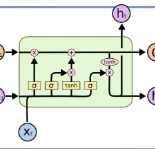With an increasing emphasis on driving down the costs of Operations and Maintenance (O&M) in the Offshore Wind (OSW) sector, comes the requirement to explore new methodology and applications of Deep Learning (DL) to the domain. Condition-based monitoring (CBM) has been at the forefront of recent research developing alarm-based systems and data-driven decision making. This paper provides a brief insight into the research being conducted in this area, with a specific focus on alarm sequence modelling and the associated challenges faced in its implementation. The paper proposes a novel idea to predict a set of relevant repair actions from an input sequence of alarm sequences, comparing Long Short-term Memory (LSTM) and Bidirectional LSTM (biLSTM) models. Achieving training accuracy results of up to 80.23%, and test accuracy results of up to 76.01% with biLSTM gives a strong indication to the potential benefits of the proposed approach that can be furthered in future research. The paper introduces a framework that integrates the proposed approach into O$\&$M procedures and discusses the potential benefits which include the reduction of a confusing plethora of alarms, as well as unnecessary vessel transfers to the turbines for fault diagnosis and correction.
翻译:由于越来越强调降低近海风(OSW)部门运行和维护(O&M)的成本,因此要求探索深学习(DL)的新方法和对该领域的应用,基于条件的监测(CBM)是最近研究开发警报系统和数据驱动决策的前沿工作,本文件简要地介绍了这一领域正在进行的研究,特别侧重于警报序列建模及其实施过程中遇到的相关挑战。本文件提出了一个新想法,即从警报序列输入序列中预测一套相关的修复行动,比较长期短期记忆(LSTM)和双向LSTM(BILSTM)模型,实现高达80.23%的培训准确性,测试高达76.01%的准确性,用双线存储器测试76.01%的准确性,这有力地显示了今后研究中可以进一步采用的拟议方法的潜在好处。本文件提出了一个框架,将拟议方法纳入O$(M)程序,并讨论了潜在的好处,包括减少混乱的警报过多,以及不必要的船舶转向涡轮机。




